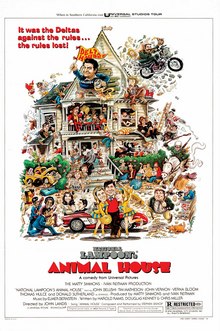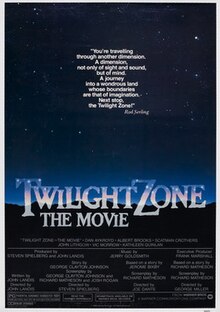Dukes Of Hazard Stunt - Indian Dunes
John Landis
Born into the Jewish family of Shirley Levine Magaziner and Marshall Landis on 8/3/1950 in Chicago, Illinois, Landis gets the movie bug after his parents relocate to Los Angeles, and in 1958, he sees the Ray Harryhausen classic, The Seventh Voyage of Sinbad, for the first time and hooked, the young boy decides he wants to become a director. Beginning as a mailboy at 20th Century Fox, Landis moves from a studio "go-fer" through various other production jobs until he gets his big break while working on Kelly's Heroes in Europe, stepping in to the role of assistant director when the man assigned the job becomes too ill to continue and is sent home. One step away from his goal of directing, he works on Sergio Leone's epic spaghetti western, Once Upon a Time in the West, John Guillermin's El Condor, while also writing, acting, and doing stunts. In 1973, at only 21, he gets the green light to film and act in the horror comedy he has also written, Schlock ... which is exactly what the film is.

Schlock Movie Poster - And Yes,
Landis Is The Monster
Schlock a dud, Landis acts in Battle of the Planet of the Apes and Death Race 2000, before getting his next chance to direct, helming the anthology comedy film, The Kentucky Fried Movie in 1977 ... a modest success that gets Landis the recommendation to film a comedy about warring college fraternities for Universal Pictures, and when 1978's National Lampoon's Animal House hits (filmed for $2.8 million, the film gathers a gross of over $141 million on its first theatrical release) ... Landis hits too, becoming Hollywood's latest wonder kid. Moving from success to success, Landis directs, writes, and acts in The Blues Brothers and An American Werewolf in London, directs, produces, and writes a documentary about Universal's legendary movie monsters narrated by Jamie Lee Curtis called Coming Soon, and has yet another comedy hit when he directs Eddie Murphy and Dan Aykroyd in Trading Places. For his next project, Landis decides he wants to produce (along with Steven Spielberg) and direct an anthology movie based on one of his favorite TV shows when he was growing up (and also write the prologue and one of the tales) ... a big budget, Hollywood production of Twilight Zone: The Movie (it stars Vic Morrow, Scatman Crothers, Kathleen Quinlan, John Lithgow, Dan Aykroyd, Albert Brooks, features narration from Burgess Meredith, and has sections directed by Spielberg, Joe Dante, and George Miller).

National Lampoon's Animal House
Three old Twilight Zone episodes told again and a fourth new tale, Landis takes on the new story, writing, producing, and directing a story of racism, changed identities and time travel he calls Time Out, starring 53-year-old Vic Morrow (a veteran of both TV and movies, his most famous role is on ABC-TV's 60s show, Combat, playing Sgt. Chip Saunders). Moving from the present time, back to Nazi Germany, on to the rural American South of the 1950s, then into the Vietnam War, before returning to present times, the Bull Connor racist character played by Morrow is redeemed when he saves the lives of two Vietnamese children ... at least that was the plan. Violating numerous labor laws for the state of California (ignored required permits, under the table payments, no special wavers for night work by children), and shrugging off warnings about the danger of the special effects he wants on screen, at around 2:30 on the Friday morning of 7/23/1982, it is time to film the big rescue (and mocking the Fates, that don't like to be mocked, Landis makes a joke about maybe losing the chopper he is flying in).

Movie Poster

Morrow As Sgt. Saunders
Morrow escaping across a river with two Vietnamese children in tow (child actors, seven-year-old Myca Dinh Le and six-year-old Renee Shin-Yi Chen ... with the parents nearby on the set, and told not to tell any of the firefighters present that children are involved in the scene), mortar effects are set off with the helicopter filming the scene (a Bell UH1 Iroquois only 25 feet off the ground piloted by Vietnam veteran, Dorcey Wingo ... at trial, there will be testimony that Landis calls for it to go even lower right before the carnage takes place) overhead, but too close to the explosions and the blast of pyrotechnics causes the chopper's tail rotor to first fail, and then fall off ... and in falling, it's blades cut off the heads of Morrow and Le, and crush Chen to death (incredibly, Morrow is scripted to say, "I'll keep you safe, kids. I promise. Nothing will hurt you, I swear to God.") Meanwhile, the damaged chopper spins out of control and crash lands on the bank of the river, injuring the six occupants aboard, including Landis. Disaster ... and there are two many witnesses to cover up what has happened, and also, it is all on film.

A Bell UH1 Iroquois
Le (L) & Chen (R)
Seconds Before
Morning's Light
Three dead and six people injured in the "accident," the incident sets off almost ten years of criminal and civil actions that result in settlements out of court for the heirs of Morrow and the parents of Le and Chen, and Landis, Wingo, associate producer George Folsey, Jr., production manager Dan Allingham, and explosives expert Paul Stewart all being tried (it takes nine months) and somehow acquitted of manslaughter charges (District Attorney Lee D'Agostino, the losing prosecutor, will accuse Landis over believing he is above the law) ... just a big ooops for those involved and lets move on, the director makes more Hollywood bucks by directing another Eddie Murphy comedy in 1988, Coming to America as he puts the tragedy in his rear view mirror (the tragedy however ends his friendship with Steven Spielberg).
Call Out The Big Guns And Get Me Off
Charming
Culpable cleared, there is a silver lining though ... determined to tighten up the industry's safety standards, Warner Brothers Vic President, John Silva, convenes a committee to create safety standards for every aspect of filmmaking, and the committee includes every Hollywood union and guild. The committee's codicils were then collected into a set of employee bulletins known as the Injury and Illness Prevention Program by which the industry would police itself (the standards are re-evaluated and updated every time there is an accident ... for instance, when stuntman Dar Robinson ruptured his spleen and died at a remote filming location of the Million Dollar Mystery, guidelines were changed to mandate on-set ambulances),with insurance companies giving blessings and okays before production and on sets each day of filming (the Screen Actors Guild will create a 24-hour hotline and safety team for its members). And there are now risk managers on sets who can evaluate the risks in a scene, and stop them if they deem it necessary ... whether the director likes it or not. As Steven Spielberg will relate while remembering the tragedy and his lost friendship with Landis, "No movie is worth dying for. I think people are standing up much more now than ever before to producers and directors who ask too much. If something isn't safe, it's the right and responsibility of every actor or crew member to yell, 'Cut!'" Amen to that!
Spielberg
No comments:
Post a Comment